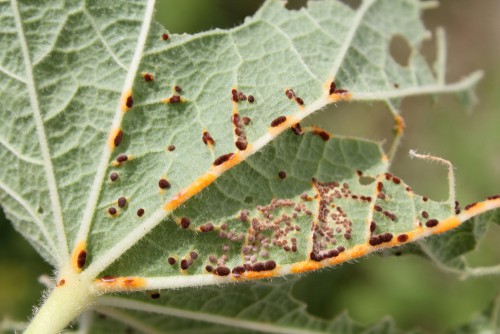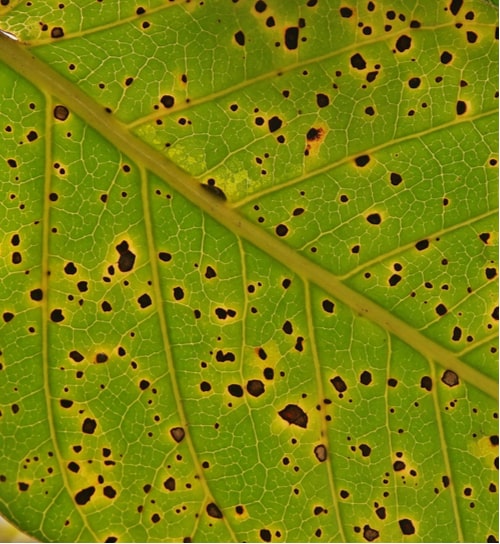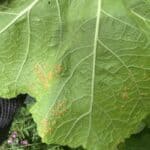Last updated on May 5th, 2022
Our site is reader supported, this means we may earn a small commission from Amazon and other affiliates when you buy through links on our site.
Hollyhocks are grown for the vibrant flowers that appear on the top of the large flower stalks. As a herbaceous perennial it’s commonly grown as an annual, and they are great for attracting bees and butterflies. They are also resistant to verticillium wilt. However, that does not mean that Hollyhocks don’t have their fair share of other diseases and we start our guide on the most common and sadly the most destructive disease, Hollyhock rust.
Hollyhock rust (Puccinia malvacearum)
Hollyhock rust is a fungal disease that manifests in the form of orange, brown, or rust-coloured pustules that appear along the foliage. If you don’t treat the problem it leaves the leaves wilted and discolored.
Splashing water or wind will spread the pustules of fungus from one leaf to another and from one plant to another. While this doesn’t threaten the overall life of your plant in most cases, it is still a serious annoyance.

You can control it using chemical fungicides that you spray on the foliage and regularly apply throughout the growing season. It’s hard to control, even with fungicides, and often you need to spray plants twice a week during the growing season for it to be successful.
Read our detailed guide on how to prevent and treat Hollyhock rust by clicking here
Leaf Spot Disease
Leaf spot disease is another fungal pathogen that manifests in spots that appear on the surface of the leaves. The size of the spots ranges from small dots that appear periodically on the leaves or large dots that cover the entire surface of the leaves. The colour of these dots can range from black to brown to yellow and orange.
This fungal disease, much like rust, won’t typically cause long-term damage if you have young and healthy Hollyhock plants. However, if you have an older plant or one that is already at a disadvantage healthwise, perhaps it’s malnourished or dehydrated, it can cause significant damage. The best form of control is proper sanitation and the removal of any infected leaves as soon as you see them and spraying with a fungicide.
Anthracnose Fungus

Anthracnose is a fungal pathogen that usually appears in humid weather. You will notice it because tan, red, or black spots appear on your Hollyhock leaves. As the disease progresses any infected foliage turns yellow, wilts, and falls off.
By applying a bordeaux mixture at the beginning of spring you can prevent the disease from attacking your Hollyhock. The bordeaux mixture does contain hydrated lime and copper sulphate so it’s quite commonly applied for other fungal diseases as well and is something you can apply throughout the growing season.
Controlling Hollyhock Diseases
Remove any diseased leaves around the plant from the floor
Hollyhock diseases are best controlled with preventative care. First and foremost, remember that fungal pathogens will drop off infected leaves or dead material and remain in the soil over winter. So, if you have any affected foliage fall that has any level of infestation and you don’t remove it from the soil at the end of each growing season, it could hold in pathogens infecting the soil and germinate the following spring.
Improve air circulation
The conditions have to be appropriate, moist, and humid, with very little airflow in order for these fungal infections to spread. To that end, if your plants are overcrowded, prune them to provide enough airflow throughout all of the stems and the leaves.
Remove any weeds from around plants
Try to keep the area around your Hollyhock plant free from any weeds. Weeds might harbour fungal pathogens and insects that attack your plants, so removing weeds can reduce the chances of any problems in the future.
That being said, if you do notice any of the major diseases listed above that have already manifested, you can apply preventative measures in conjunction with removing the infected debris and applying fungicides for severe cases.
Last update on 2025-07-02 / Affiliate links / Images from Amazon Product Advertising API





